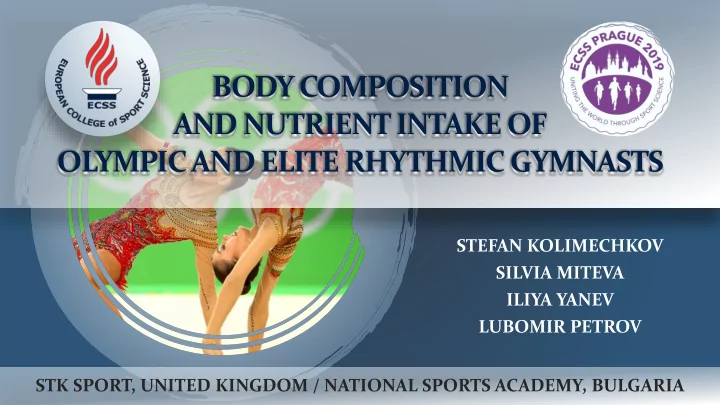

BODY COMPOSITION AND NUTRIENT INTAKE OF OLYMPIC AND ELITE RHYTHMIC GYMNASTS STEFAN KOLIMECHKOV SILVIA MITEVA ILIYA YANEV LUBOMIR PETROV STK SPORT, UNITED KINGDOM / NATIONAL SPORTS ACADEMY, BULGARIA
A IM OF THE S TUDY The purpose of this study was to assess the body composition and nutrient intake of top level Olympic and elite rhythmic gymnasts from Bulgaria, in comparison with published international guidelines for gymnasts and the healthy norms for females. 2
M ETHODS BODY COMPOSITION Participants 21 elite rhythmic gymnasts The measurements from the Bulgarian National Team were conducted at the • First National Team (2016 Olympic bronze National Centre of Sports Medicine in Sofia, Bulgaria medallists, n=5, mean age 24.2 ± 2.7); • Second National Team (2017 World Silver and • Height, weight, circumferences 2018 World Gold Medallists, n=8, age: 17.8 ± 2.4); and skinfolds were measured • Junior National Team (n=8, mean age 12.6 ± 0.5). 3
M ETHODS NUTRITIONAL ASSESSMENT BODY COMPOSITION Food frequency BMI and percentile scores of height, questionnaire was applied. weight and BMI were computed, by using specialised WHO software. Based on the results, the relative energy needs and energy • %Body fat was determined by using Slaughter’s intake, RPI, RCI, RFI, and the energy contribution of (1988) equations for female adolescents and protein, carbohydrates and fat Jackson & Pollock’s (1980) equation for women. were calculated. • %Muscle mass was calculated by using Poortmans et al’s (2005) & Lee et al’s (2000) equations. 4
M ETHODS STATISTICAL ANALYSES WEIGHT MANAGEMENT 1. For how much time before a competition The statistical analyses do you follow a strict diet? were conducted with SPSS 2. Which nutrients do you avoid in your diet? Statistics 19 software, using descriptive statistics and 3. What methods do you apply for dehydration? One-way ANOVA with the 4. What other methods do you apply to reduce Bonferroni post hoc test. your body weight? 5. Where do you get information on diet and The data is presented as weight management from before a competition? mean ± SD. 6. For how many days after a competition do you allow yourself a free nutritional regimen? 5
R ESULTS & D ISCUSSION ANTHROPOMETRIC PARAMETERS First National Second National Junior National Team (FNT) Team (SNT) Team (JNT) n=5 n=8 n=8 Age (years) 24.2 ± 2.7 BC 17.8 ± 2.4 C 12.6 ± 0.5 Sports experience (years) 18.4 ± 1.1 BC 13.3 ± 2.1 C 7.3 ± 1.9 Height (cm) 172.0 ± 4.1 C 169.1 ± 3.0 C 155.3 ± 4.4 Weight (kg) 38.1 ± 4.3 54.6 ± 2.4 C 52.4 ± 2.7 C Ideal weight (kg) 51.4 ± 2.0 C 53.4 ± 3.4 C 37.4 ± 3.7 BMI (kg/cm 2 ) 18.5 ± 0.4 C 18.2 ± 0.6 C 15.8 ± 1.1 14.2 ± 7.6 BMI percentile score 8.7 ± 7.5 B – p < 0.001 vs Second National Team; C – p < 0.001 vs Junior National Team 6
R ESULTS & D ISCUSSION E QUATION FOR DETERMINING THE I DEAL W EIGHT IN G YMNASTS Ideal Weight = Height (cm) - 118 7
R ESULTS & D ISCUSSION % B ODY F AT AND M USCLE M ASS First National Second National Junior National Team (FNT) Team (SNT) Team (JNT) n=5 n=8 n=8 %BF 13.9 ± 6.8 17.0 ± 5.6 15.6 ± 2.2 percentile score 14.3 ± 21.9 17.3 ± 26.6 4.3 ± 4.9 Effect size vs 50 PRs 1.63 d 1.23 d 9.42 D Muscle mass (%) 37.6 ± 1.1 44.0 ± 2.3 bC 40.5 ± 1.2 c b – p < 0.01 vs Second National Team; c – p < 0.01 vs Junior National Team; C – p < 0.001 vs Junior National Team d – p < 0.05 vs 50 th percentile; D – p < 0.001 vs 50 th percentile 8
R ESULTS & D ISCUSSION ENERGY INTAKE (kcal/kg) 70 FNT SNT JNT 60 * 50 * * kcal/24h/kg 40 62.3 30 ≥ 40 kcal/kg 50.3 47.9 40.3 40.7 20 38.7 Guidelines for female gymnasts 10 (Dallas et al. 2017) 0 Relative Energy Needs Relative Energy Intake (kcal/24h/kg) (kcal/24h/kg) 9 * - p < 0.05 vs REN ** - p < 0.01 vs REN
R ESULTS & D ISCUSSION 6.0 5.0 FNT SNT JNT ≥ 5 g/kg 4.0 g/24h/kg (Dallas et al. 3.0 2017) 5.11 4.95 4.58 2.0 1.0 1.95 1.70 1.68 1.62 1.40 ≥ 1. 5 g/kg ≥ 1. 5 g/kg 1.27 0.0 PROTEIN FAT CARBOHYDRATES (g/24h/kg) (g/24h/kg) (g/24h/kg) 10
R ESULTS & D ISCUSSION PROTEIN – E% PROTEIN % FNT SNT JNT ANIMAL VS PLANT-BASED 17.4% 15% * 17.6% 37.2% 40.1% 43.0% 57.0% (Dallas et al. 2017) 59.9% 62.8% ** 19.4% 0% 5% 10% 15% 20% 11 * - p < 0.01 vs the Guidelines; ** - p < 0.001 vs the Guidelines
R ESULTS & D ISCUSSION Which nutrients do you avoid Where do you get information on in your diet? diet and weight management from? Dietitian n=9 Internet Salt n=7 n=9 Carbohydrates n=19 Literaturen=2 Proteins n=2 Team members n=4 Coach n=18 Fats n=17 12
C ONCLUSIONS When identifying the ideal weight of rhythmic gymnasts, coaches should take into account not only the body image and sports- related criteria, but also the recommended health-related norms for body composition in women. Rhythmic gymnasts should maintain their ideal weight without diverging greatly from the recommended nutritional guidelines. 13
THANK YOU Stefan Kolimechkov PhD www.stk-sport.co.uk dr.stefan.kolimechkov@gmail.com 14
Recommend
More recommend